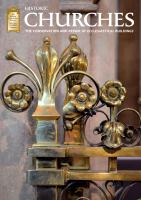

BCD SPECIAL REPORT ON
HISTORIC CHURCHES
22
ND ANNUAL EDITION
37
THE AYG YEW LISTS
Using the firm knowledge it has gathered,
the Ancient Yew Group has produced a
list of all the known significant yews in
Britain. Every yew on the list is considered
particularly worthy of careful protection
and is rated ‘ancient’, ‘veteran’ or simply
‘notable’. Just over 1,000 churchyards in
England contain AYG-listed yews, and
154 of them contain ancient specimens.
In Wales there are nearly 350 churchyards
with yews of note, and of these 84 contain
ancient trees. While the list of notable
yews remains a work in progress, the
group believes it has covered almost all
churchyards which have an ancient or
veteran yew, and the information for each
church and diocese is freely available on
the AYG website.
IS OUR YEW ANCIENT?
A simple means of assessment is to
measure the girth of the yew’s trunk at
its narrowest point. If it exceeds – or is
known in the past to have exceeded – five
metres in girth, the tree is likely to be
veteran. If the girth exceeds seven metres
then it is probably ancient. Sometimes it
can be demonstrated that smaller yews
are likely to be veteran or ancient. If you
have a large unlisted yew, please contact
the AYG via its website and a specialist
will come and assess it.
AGEING AND REGENERATION
As they progress through various life
stages old yews come to the attention
of those responsible for churchyard
maintenance. Some individual yews are
explored below exemplifying problems
and maintenance issues and solutions.
Among the yews which can be
considered for pre-Christian status is the
large yew in the churchyard at Tandridge,
first documented in
A Topographical
History of Surrey
by EW Brayley (1841): ‘At
the west end, is a large decayed yew-tree,
split into four or five parts, and in a state
of rapid decay. At five feet [1.5 metres]
from the ground, its circumference is
nearly thirty feet [9.1 metres]’.
Although reported to be in a state of
serious decay in 1841 the tree survived and
now flourishes as one of the best and most
spectacular specimens in the world. The
lesson of history is that very old yews can
regenerate satisfactorily, and seemingly
irreversible decay and destruction of parts
are incidents which, in the long-term, the
organism takes in its stride.
The Tandridge yew’s base
circumference was less than 10.5m when
recorded in 1890, and in the last 125
years it has increased during the flush
of regeneration by 53cm to nearly 11m.
This increase is likely to be faster than
the growth rate during the earlier period
of decay when girth increase may have
virtually stalled. The yew’s projected age
exceeds two millennia, placing the tree
in the illustrious company of yews at
Farringdon and Breamore in Hampshire,
the two Crowhursts in Sussex and Surrey,
Herstmonceaux in Sussex, Ashbrittle in
Somerset, Norbury in Shropshire, and
Llangernyw, Discoed and Bettws Newydd
in Wales among others.
The Tandridge yew’s successful
regeneration is very likely in large part
due to the canopy being allowed to grow
freely, and the fact that a fractured and
subsided trunk section was allowed
to grow out along the ground towards
the lych gate. Around the time of the
first world war when the tree had
considerably recovered, most of the
fallen trunk section was removed, but
two substantial layers were sensibly left
as by then it had established roots of its
own. The result is that we now have new
young trees that are genetically identical
with the original.
Here is a way forward in terms of
a philosophy of maintenance. Yews
have many survival mechanisms, and
sometimes what looks to human eyes
like a disaster may be one of these
mechanisms in progress. On the
whole, where there is no likelihood
of damage to persons or property
a yew should be left alone.
There are occasional exceptions,
however. At Long Sutton churchyard
in Hampshire a hollow ancient yew has
been effectively propped. The treatment
here is an excellent example of best
practice. The tree is so hollow that the
‘walls’ of the trunk are only barely capable
of supporting the re-growth of branch
material emanating from them and there
were occasional losses, as in 2000 when
a metre wide section of trunk fell when
overloaded by snow. Another fallen
section has long been allowed to lie in
situ, where it continues to grow.
A number of safe propping methods
exist, at Wilmington in Sussex telegraph
poles have been used to good effect, while
at Long Sutton the props are squared
timber with a footplate to prevent them
from sinking into the ground, and
rubber ties to prevent movement at the
join between the prop and the branch.
Propping should always be carried out
by a qualified arboriculturist. Although
trouble-free when done expertly, this
work has potential hazards, not least that
an incorrectly installed prop fails, causing
damage or injuring someone. The safety
of props needs regular review and an
arboriculturist’s plan should detail such
aftercare. From a procedural point of
view, proposals to prop a branch should
be treated as if the tree was to be cut and
a faculty is required.
The vast yew at Tandridge churchyard in Surrey
(All further photos: Toby Hindson)
The extraordinary complexity of the Crowhurst yew in Sussex has developed over
two millennia or more, making the tree unique and irreplaceable
















